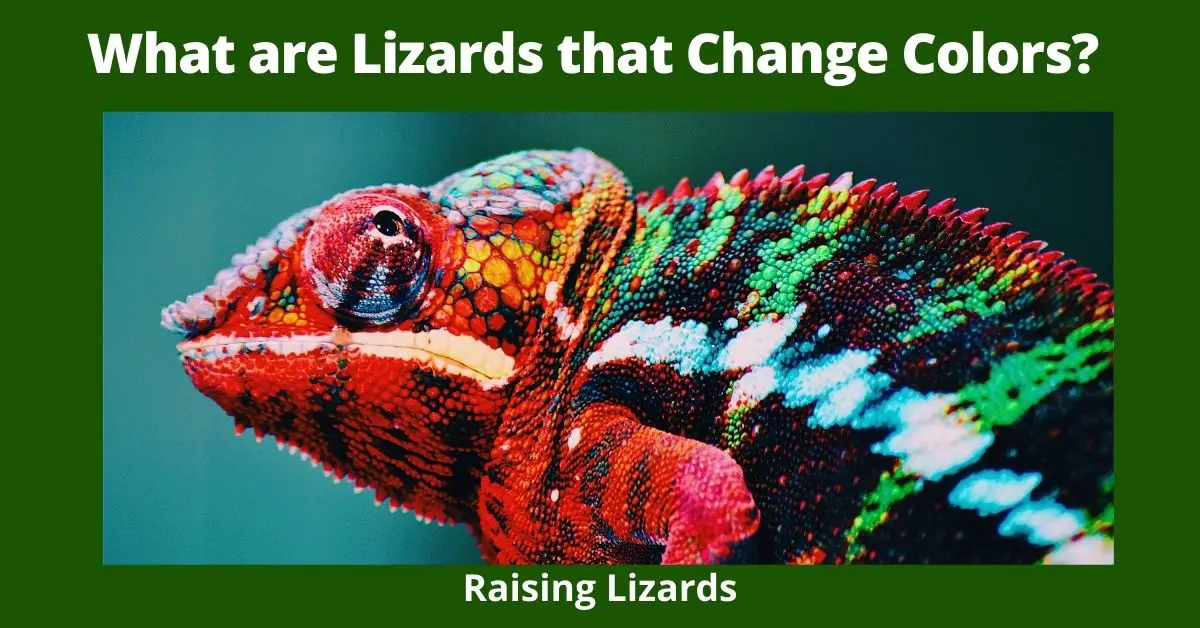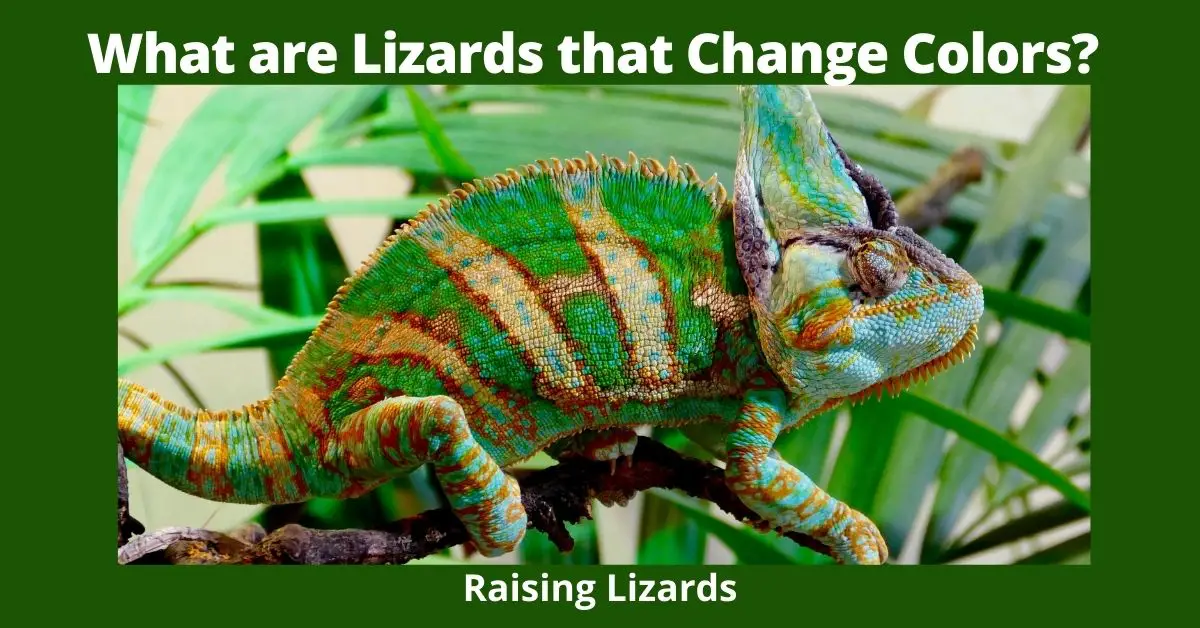Lizards that change colors are chameleons, skinks, and anoles. The process is called metachrosis. It can be either passive or active. There are over 400 different color variations.
What are Lizards that Change Colors?
Do you know what lizards that change colors are? These amazing creatures can be found all over the world, and they can change their colors to match their surroundings. This helps them to stay safe from predators and also helps them to capture prey. There are many different species of lizards that change colors, and each one has its own unique coloring pattern. In this blog post, we will take a closer look at these fascinating animals! Jump to Do All Lizards Change Color?
What are lizards that Change Colors?
Lizards that have the ability to change color are called chameleons. There are over 160 different species of chameleon, and they can be found in Africa, Europe, Asia, and North America. Chameleons have two layers of skin – an outer layer that is transparent, and an inner layer that contains the colors that the chameleon displays. The color of a chameleon’s skin depends on its mood, temperature, and surroundings. For example, if a chameleon is feeling scared or stressed out, it will turn a darker color to blend in with its environment. If a chameleon is hot or angry, it will turn a lighter color to cool down.

How do Lizards Change Colors?
Lizards are masters of color change. They do it to blend in with their surroundings or to express emotion or attract a mate. Different species have different methods and reasons for changing colors. The chameleons, with their ability to match the colors around them, are perhaps the most well-known example of this ability among lizards. But several other lizard families also use color changes as a means of communication and camouflage. What are Lizards that Change Colors?
The other lizards are the smallest group of lizards, with fewer than 300 species. They include geckos and skinks.
Most geckos can change color to some degree. But many don’t need to because they are nocturnal creatures that hunt at night when their predators may not be so vigilant for them anyway. Instead, these small lizards use camouflage as a way to hide from other animals during daylight hours.
Their skin is thickly covered in tiny scales called tubercles that absorb light and reflect it back out again as a dark color or shadow on the surface of their skin. This helps keep them hid during both day and night hours when they aren’t moving around much.
What is Metachrosis?
The process that lizards use to change colors is called metachrosis. This can be done in order to blend in with their surroundings, or as a warning signal to predators. The skin of a lizard is covered in tiny scales that can change color quickly. This allows them to adapt to their environment and avoid being seen by predators or prey.
There are several different methods that lizards use to change colors. Some species will rely on changes in the environment, such as light levels or temperature. Others will use special muscles to adjust the color of their scales. And some species will even change color depending on their mood!
The two types of Metachrosis are:
- Active Metachrosis: This is when the lizard changes color deliberately, in order to blend in with its surroundings or send a warning signal.
- Passive Metachrosis: This happens when the color of a lizard’s scales changes as an automatic reflex, such as in response to temperature or light levels.
The two types of Active Metachrosis are:
- Emotional Color Change (Blushing): This is when a lizard turns red due to embarrassment or anger. It can also be used as a warning signal for predators!
- Camouflage Color Change (Mimicry): This is when a lizard blends into its surroundings in order to avoid being seen by prey and predators alike.
What is the number of color variations that lizards are capable of?
There are many different color variations for lizards and more are being discovered all the time! So far, we’ve seen about 400 different color combinations but there could be thousands more out there waiting to be found!
Lizards are known to have a wide range of colors. Some of these lizards are black, some white and others green. But what is the number of color variations that they can have?
This question is not easy to answer but it has been studied extensively by scientists from many different fields including biology, genetics, and biochemistry among others. The research shows that there are several factors that affect how much variation a lizard has in its skin pigmentations or even if it does at all! These include environment (temperature), diet (whether the animal eats insects or not), and age (for example younger animals tend to be lighter than older ones).
In general, though most studies show no correlation between absolute size (like length or weight) and color variation so it seems likely that these differences result from other factors such as environmental conditions which vary with geographical location.
There are hundreds of different species within the genus Anolis which means there could potentially be thousands more than just those listed here!
It is usually considered a type of camouflage, but it can also be used for communication or courtship. In some species, like geckos and chameleons, this color change process is involuntary – the lizards don’t have any control over their skin color at all. But in others, like anole lizards (Anolis carolinensis), they choose when to change colors based on their bodies’ signals and external conditions such as temperature and light levels.
The common Major Colors are:
- Black
- White
- Green
- Brown
- Orange
- Red

What are the Reasons that Lizards Change Colors?
The Reasons that Lizards change their color are:
- Mood – Lizards change their color to match the mood they are in.
- Temperature – Lizards change their color based on temperature, light and humidity.
- Camouflage – Many lizards can also blend into their surroundings by changing colors to make it harder for predators to spot them. Some species of lizard will even develop new colors if they find themselves living in a new environment… Do not write numbers or bullet points.
- Anger – Many lizards turn a darker color when they are angry.
- Thermoregulate – Some lizards will change colors to cool down or warm up.
- Sexual Selection – In some cases, the color of a lizard can be used to attract a mate.
- Rivals – Some lizards will also change colors to intimidate rivals.
- Injured – Some lizards will also change colors to signal that they are injured.
- Sick – Some lizards will also change colors to signal that they are sick.
- Egg Laying – Many female lizards will lay eggs in a specific color, and will then change their own color to match the eggs.
- Predators – Many lizards change colors to blend in with the background, making it harder for predators to spot them.
- Bonding – Some lizards will also change color when they bond with another lizard.
- Environment – Many lizards will adapt their color based on their environment, helping them to camouflage themselves better within that particular area.’
- In Conclusion,
Final Thoughts – What are Lizards that Change Colors?
The ability to change colors is an amazing adaptation that allows chameleons, skinks, and anoles to survive in a variety of different habitats. By understanding the process of metachrosis, we can appreciate these creatures even more for their unique abilities.


